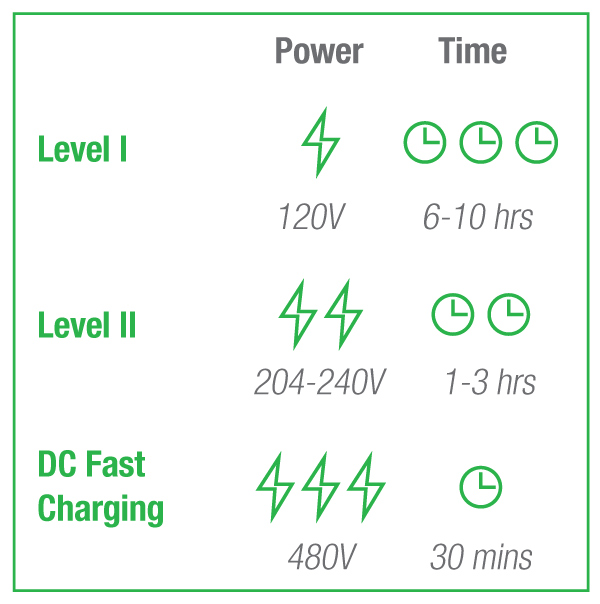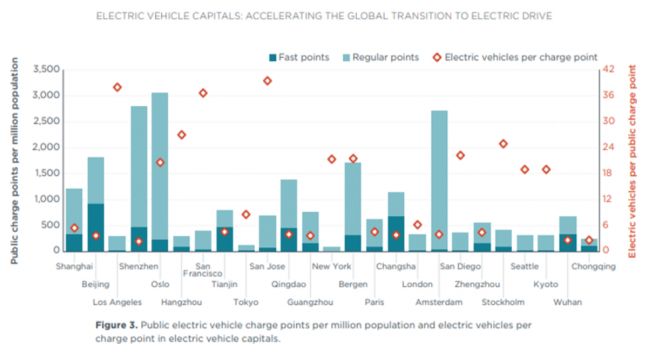Fast Facts: Electric vehicle charging
10 December 2019
by Christopher Carey
In a new series of explainers, we provide a quick-fire briefing for city officials including highlighting which cities to look to for guidance and inspiration. By Christopher Carey
Types of charging

Those new to this concept can find that information on how charging works and what’s available is often as clear as mud. Differing charge speeds, voltages, prices, plugs, sockets and battery types as well as a range of private operators vying for their slice of the burgeoning electric vehicle (EV) market, have led many city authorities to shy away from addressing what should be simple questions with simple solutions.
Cities across the globe are now facing these questions head-on as the shift towards zero emissions has firmly entered the public policy debate.
Level I, commonly known as ‘slow charging’ constitutes the majority of home charging and can take anything from 6-12 hours for a full charge (2-4 hours for a hybrid), at a power of three kilowatts (kW). The make/model of the car and location (US/Europe have different voltages) can also impact charging speeds.
Level II, often known as ‘fast charging’, is used for most street public charging units, such as those installed by cities, and can take between 1-3 hours at a power of 7-22 kW.
Rapid chargers are one of two types—AC or DC [Alternating or Direct Current]. Current Rapid AC chargers are rated at 43 kW, while most Rapid DC units are at least 50 kW. Both will charge the majority of EVs to 80 percent in around 30-60 minutes (depending on battery capacity). Tesla Superchargers are also Rapid DC and charge at around 120 kW.
Costs for charging units vary considerably, but range from £10,000 (US$12,500) for a Twin 7Kw street fast charger to up to £50,000 for a Rapid DC 120 Kw.
Where to charge?
The good news, especially for low-density cities, is that the vast majority of EV charging takes place in the home or at the workplace.
The bad news is that not everyone has access to off-street private parking.
Alexander Lewis-Jones, EV Product Manager at Delta Energy & Environment says that public charging is a tiny fraction of the overall EV charging picture.
“People buying today are charging at home, and if not at home, at the workplace,” he explains. “It’s completely tied with parking–wherever you park your car, that’s where you charge.”
The leading cities
EV ownership, charging infrastructure and policy varies considerably between countries. While China has the highest EV unit sales as a whole, in terms of the number of charging points, Oslo and Amsterdam are head and shoulders above other cities outside China on a per capita basis (see graphic).

Oslo
For EV charging infrastructure and ownership, Norway leads the way. Despite having a population of just over five million there are approximately 230,000 EV’s in the country, constituting eight percent of all passenger vehicle ownership–the highest proportion in the world.
Almost 50 percent of all new cars sold in the first six months of 2019 were fully electric, up from just over a quarter during the same period the previous year.
The shift to electric has been dramatic, but it didn’t happen overnight. A range of EV-friendly policies have been introduced over the past three decades which have provided crucial financial incentives for drivers in the Nordic country.
The removal of the vehicle purchase tax, annual motor vehicle tax and charges on toll roads and public ferries have made EVs the most cost-effective option for motorists–often on a par, or even cheaper than petrol/diesel versions.
Other perks such as being permitted to drive in bus lanes and the free use of municipal car parks has seen EVs explode in popularity.

“Really it’s all about the money,” says Unni Berge, Head of Communication and PR at the Norwegian EV Association. “Many people come to Norway and ask: ‘Are EVs popular because you’re all so environmentally friendly?’ Of course, a lot of EV drivers here are but ultimately it’s all about the cost, and EV’s are simply more financially efficient.”
In the nation’s capital Oslo, which has a population of 680,000, there are currently 2,025 public charge points, 1,325 of which are owned by the city. In 2008 it became one of the first cities in the world to deploy on-street chargers and visibility is key to public acceptance.
Sture Portvik, Project Leader and Manager of Electro Mobility at the City of Oslo, says: “We started by installing them in front of the city hall and at other highly visible locations, because it was important that people could see them so that they knew charging was available.”
In recent years the city has started to cooperate with the private sector to install rapid chargers (50Kw+) in a bid to meet the needs of those who need a top-up on the go. There are currently 200 rapid charger outlets (50 kW+) in the city.
With more than half of Oslo’s residents living in apartments, an increasing number of buildings are installing charge points in garages to facilitate EVs. A government regulation passed in 2017 guarantees apartment owners the right to install charging infrastructure provided there is space.
“We are not 100 percent sure about how many apartment dwellers actually have access to private off-street parking, nor how many with a designated parking space have access to a source of power, but this is now being mapped,” adds Portvik.
The lack of single dwelling houses means innovative thinking is needed to meet demand for charging and the concept of the ‘charging hub’ has been increasing in recent years, as space and regulatory issues can limit a city’s ability to install individual on-street chargers.
One of the largest and most advanced EV charging garages in Europe was opened in 2017, thanks to EU funding. With over 100 EV chargers, quick chargers and additional battery storages for smart charging, ‘Vulkan’ serves more than 400 EVs on a daily basis and has become a symbol of Oslo’s success. In March, Oslo announced that it will introduce wireless charging stations primarily to assist taxis while they wait at stands. All taxis must be zero emission from 2023.
Further Information
Norwegian EV Association:
elbil.no/english/about-norwegian-ev-association/
Charging infrastructure experiences in Norway:
wpstatic.idium.no/elbil.no/2016/08/EVS30-Charging-infrastrucure-experiences-in-Norway-paper.pdf
Wireless charging for taxis:
Amsterdam
The city first rolled out its street EV charging stations (mostly 11Kw) in 2009, and there are currently 3,000 public charge points in the Dutch capital.
A demand-driven model means members of the public can simply apply for one to be built near their home, and if an alternative is not available to them, a unit will be built by the city provided there aren’t other chargers in the area within walking distance to a person’s home.
This approach means the city does not install chargers in areas where they will not be used, as has occurred in other major cities, such as London.
“We really view our charging stations as being part of a network,” says Jaap Burger, EV Charging Strategy Advisor at the City of Amsterdam. “Although we started with individual units, the network has allowed us to gather data and make informed decisions.”
 As the system expanded, city authorities monitored usage and adapted policy to consider different user groups, such as taxis and ride-sharing vehicles.
As the system expanded, city authorities monitored usage and adapted policy to consider different user groups, such as taxis and ride-sharing vehicles.
While it can take up to five months from the initial application to the charge station being installed, Burger says the system is pragmatic for road users.
“Most drivers know well in advance when they will be getting their EV, as wait lists can be up to 12 months, so they can apply for a station to be built after they order their car.”
He adds that Amsterdammers have confidence in the city’s charging infrastructure and know that if a charge point is needed, it will be installed.
With 80 percent of the city’s residents not having access to off-street parking, there is a high reliance on the public charging network.
The continued expansion over the years soon gave way to another concern–how could the city’s electricity grid cope? An EU-funded initiative that regulates the flow of charge speeds is helping to address this.
Flexpower, a collaboration between the city, academics and private industry, is developing smart charging for the capital’s EV-charging network.
With demand and supply closely monitored, charge speeds can be increased at night or decreased at peak times to avoid overburdening the infrastructure. As the Dutch national grid is closely linked to renewable energy, strong winds and sunny days lead to faster charging, and vice versa.
To date, about a third of Amsterdam’s EV charging stations are linked up to the smart charging network.
Anthony Hinde, Sales and Operations Director at Vattenfall, one of the project’s partners says: “What we have found after two years of operations is that most people are plugging in at times when they can get faster charging and they will use a unit that gives them the fastest charge at off-peak times.”
Further Information








